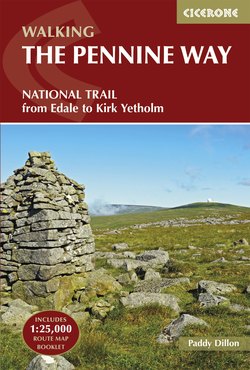Читать книгу The Pennine Way - Paddy Dillon - Страница 12
На сайте Литреса книга снята с продажи.
ОглавлениеCatrake Force is passed on the way out of Keld (Day 10)
PREFACE
Of all the many guidebooks I have written this one is the most personal. The Pennine Way is intricately bound up with my family history. I was born and raised only six miles from the Pennine Way and the route was opened when I was only seven years old. My family included some staunch walkers who used to talk about it from time to time. My Uncle Gerard walked the trail in its early years, returning with tales to inspire others. As young teenagers, a friend and I stumbled across a Pennine Way signpost on the moors and wondered how long it might take us to walk to Scotland. Soon afterwards, a chance copy of Alfred Wainwright’s Pennine Way Companion, laid it all out for me in black and white.
I could have walked the Pennine Way at the age of 16, but I chose to follow it northwards only as far as Cross Fell, then made a beeline for the Lake District, explored for a week and walked home via the Yorkshire Dales. I finally walked the whole route for the first time when I was 21, and it snowed for the first five days!
Throughout the 1970s, if you told anyone you were a keen walker, they would ask, ‘And have you walked the Pennine Way?’ Anyone actually walking the route might have been asked, ‘Are you walking the Pennine Way, or just walking for pleasure?’, as if the two were mutually exclusive! The route was regarded, rightly or wrongly, as something that every ‘proper’ walker should aspire to, generating something of a backlash, with some people vowing never to set foot on it.
One thing became painfully obvious throughout the 1970s; the Pennine Way was being trodden to death. Although I always enjoyed walking parts of the route, it was distinctly unpleasant to wade through the mud, occasionally plumbing waist-deep bogs where the peat had been trodden into the consistency of cold, black porridge. Apart from occasional forays during the 1980s, I left the route well alone while the problems of over-use and erosion were addressed, ultimately by completely rebuilding several stretches of the trail.
Once everything had bedded down and grassed over I renewed my acquaintance. It was worth the wait, and as the years roll by, the stone-paved paths will become as much a part of the Pennine Way as the centuries-old packhorse ‘causeys’ that preceded it. The scenery remains the same as ever and only the conditions immediately underfoot have changed, and for the better.
Following the 50th anniversary of its opening, the Pennine Way seems to be enjoying a surge of popularity. This is remarkable, as today’s walkers have many other National Trails to choose between, as well as infinite opportunities to walk challenging trails abroad. The Pennine Way remains the toughest of the National Trails; one that every long-distance walker should aspire to. Long may it enjoy a future as part of Britain’s rich outdoor heritage.
Paddy Dillon
